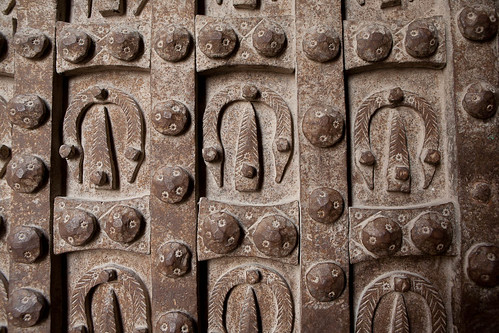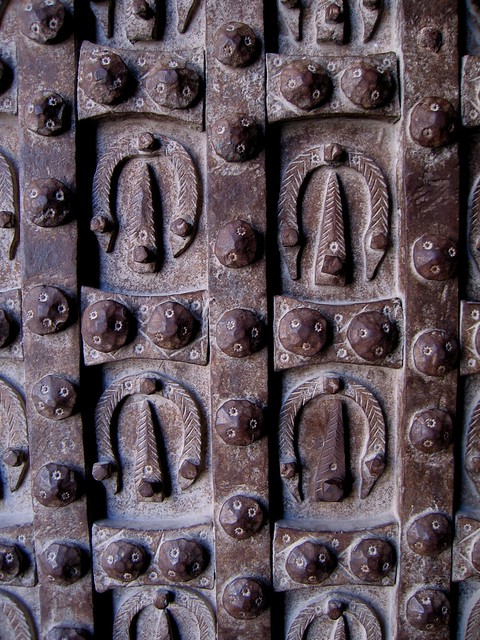Just when you think it can't get any worse, it looks like time may have run out for the ancient Syrian city of Aleppo. There is no cavalry coming to the rescue. There are no white knights on the horizon. For most, there is no more hoping-against-hope that the world will hear their pleas.
It's time for one last footnote from history, one last snapshot from the past. And, one last chance for a horseshoe legend to save its city, as it was designed to do 800 years ago.
Back when tourists and scholars from all over the world traveled to Syria to visit and study historical landmarks, one of the top destinations on their list was the citadel in Aleppo, which was designated a UNESCO World Heritage Site back in 1986. It is one of the oldest cities on our planet, dating back to 2400 BC and possibly long before that.
A citadel means, literally, "small city". Or, in the case of Aleppo, a city within a city. In some places, citadels were manmade fortresses built for defense against invaders; silos in the citadel in Aleppo could hold enough grain to feed 3000 people for five years. By then, hopefully, the invaders would give up.
Abraham grazed his sheep on the Aleppo citadel's hillside. Invaders found Aleppo easily, since it was the intersection of two trade routes on the ancient Silk Road that connected the Mediterranean with the Far East.
Aleppo's history could be charted out with a timeline of invaders. From the east, the north, from across the Mediterranean, and from the heart of Arabia, they came century after century. The Greeks were here. Alexander the Great stormed through the citadel. Then came the Romans and the Byzantines. Later, the Mongols from Central Asia did their best to destroy this place.
The next wave, Islamic invaders, converted the Byzantines' churches to mosques.
And then came the Crusades and more Christians: The citadel was attacked 22 times, but it never fell. It even withstood the attack of Nature in the form of a massive earthquake in the early 1800s. A French occupation's mandate in the 1930s was to restore the citadel, or at least preserve it. That mission would be taken over by the Aga Khan and the United Nations in the late 20th century. But in the last decade, even the most ardent historians and archeologists packed their bags and left.
Who'll rebuild it next?
If invaders make it across the 100-foot wide moat, two towering horseshoe gates will stop them in their tracks. No matter which army or tribe tried to conquer it, the citadel carried a stark message in an ancient code. The message was written in dozens of horseshoes, affixed with their heels pointing down. A wall of bad luck symbols is not exactly a warm welcome.
This story is written as if the gates are still there. We really don't know if they are or not. With the loss of human life that has occurred, perhaps it seems trivial or even callous to be writing about mere ancient relics.
The citadel rises above the old city of Aleppo, Syria.
Someone thought this place out. You reach the citadel via a towering pedestrian bridge across the moat, pass under arches, and navigate a zigzag path designed to slow charging cavalry horses down, and only then do you come upon the impenetrable iron gates. It must feel like you have been through a maze, only to find a dead end.
The New York Times reports that, more recently, snipers pointed their high-powered rifles from the narrow machicolation slots in the citadel walls.
About those horseshoes: Dozens of almost identical horseshoes are bolted onto the iron doors with the heels pointing down. Inside each shoe is a spear, pointing up. The spear tip resembles a horse's frog. The shoes look rather like serpents; each one is detailed with small chevrons, simulating a snake's skin. They are not cookie-cutter metalwork; each is slightly different. They create a wall of bad news to would-be conquerors.
And then there is the special shoe. One very different shoe is nailed among the others on one of the doors. It speaks a message to conquerors, in the event an invader would succeed in penetrating the citadel's fortification and earning the city's surrender.
Tourist photos show that the one lone shoe with its heels pointing up has a different patina from the others on the gates. No doubt tourists and passers-by rubbed it for good luck for centuries.
Photographer Bill Anderson tells us: "The horseshoes are designed to bring bad luck on attackers of the citadel, but the one set the other way up is to allow the defenders good luck if/when they sally forth."
"Be kind," in other words, is the message of the lone shoe with its heels pointing up, if you must come in. The others simply suggest "be gone"-- if you know what is good for you. Some say they represented an ancient curse that needed no translation, much as a wall covered with the skull-and-crossbones symbol of piracy would.
Why horseshoes? Along the ancient Silk Road from Europe to the riches of India and China, a horseshoe was a talisman without peer. Temple gates in India are covered with horseshoes, as well.
The catch in this story is that we have come to think of the horseshoe, when removed from the context of horse equipment, as a good luck symbol, a charm, a protector over the doors of our homes. The Aleppo legend puts the horseshoe in an even higher category of superstition, and perhaps even of non-verbal communication in the days of wars and invasions from tribes and armies who had no common language except universal symbols.
Gates and doors mattered in ancient times. It was a custom for a conquering army to not just tear down the gates of a city once it was conquered but to ship the gates home to the ruling city. Surely the massive, heavy iron gates of Aleppo, covered as they were with iron horseshoes, would have been difficult to transport, and a challenge to any conqueror. But, oh, what a prize to carry back to your home city.
No one in history ever tore them down. Even when the citadel was conquered, the horseshoe gates were left standing.
These horseshoes stood the test of time. Until time ran out.
The bad news ending for this story--and perhaps for the city of Aleppo-- comes from the World Monuments Fund, which had been more or less defending the citadel until the Syrian civil war forced workers to evacuate in 2012. According to their information, a missile attack on August 11, 2012 "damaged the citadel’s massive gate and destroyed the iron doors", which had stood for 800 years.
Destroyed the doors, perhaps. But there's no mention of destroying the horseshoes. They must be lying in the rubble. And at least one of them must have landed with its heels pointing up...or maybe they all did.
Note: While I was finishing this story today, a cease-fire was announced in Aleppo, giving more people a chance to get out.
Will Aleppo's citadel ever be rebuilt? Will someone dig through the wreckage and pick up the horseshoes, one by one, and bolt them back onto rehung doors? Will they remember where the one unique shoe goes? Will they nail them all back on with the heels pointing up, sending a "be kind" message to the world?
Or has the luck of these magnificent historic horseshoes finally run out?
Hoofmarks is a new project from Hoofcare Publishing to take readers around the world to historic and artistic landmarks related to horse hooves, horseshoes, and their people.
© Fran Jurga and Hoofcare Publishing; Fran Jurga's Hoof Blog is the news service for Hoofcare and Lameness Publishing. Please, no re-use of text or images on other sites or social media without permission--please link instead. (Please ask if you need help.) The Hoof Blog may be read online at the blog page, checked via RSS feed, or received via a headlines-link email (requires signup in box at top right of blog page). Use the little envelope symbol below to email this article to others. The "translator" tool in the right sidebar will convert this article (roughly) to the language of your choice. To share this article on Facebook and other social media, click on the small symbols below the labels. Be sure to "like" the Hoofcare and Lameness Facebook page and click on "get notifications" under the page's "like" button to keep up with the hoof news on Facebook. Click here to send an email to Hoofcare Publishing.
Follow Hoofcare + Lameness on Twitter: @HoofBlog
Read this blog's headlines on the Hoofcare + Lameness Facebook Page








